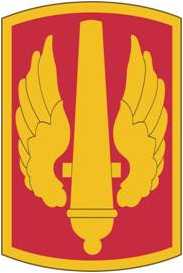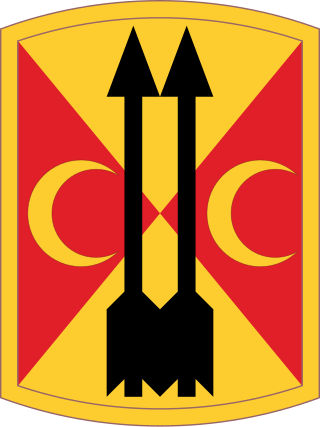Afghanistan service
The 951st Engineer Company of the 724th Engineer Battalion deployed to Afghanistan in February 2009 as part of the 276th Engineer Battalion, Virginia Army National Guard, to provide route clearance operations for Coalition forces. During this deployment the 276th completed 1090 missions and received the Valorous Unit Award while sustaining the loss of only one soldier to enemy fire. [2] Sgt. Ryan C. Adams of 3rd Platoon, 951st Engineer Company, died on 2 October from wounds sustained from an RPG attack on his vehicle. [3]
The 229th Engineer Company of the 724th Engineer Battalion deployed to Southern Afghanistan in September 2012, and expanded mobility for American and Afghan forces through numerous route improvement projects and base expansions. [4]
On 16 January 2013, Bravo Battery of the 121st FA deployed to Afghanistan. [5]
On 17 May 2014, Alpha Battery of the 1-121 FA deployed overseas to Afghanistan in support of coalition forces. [6]
Modern era redesignation
During the early 1960s, the unit was assigned the Little John. On 30 December 1967, the 32nd Infantry Division was deactivated and National Guard units realigned. Along with the 32nd Infantry Division, the 32nd Infantry Division Artillery was redesignated as the 257th Field Artillery Group. On 30 September 1978, the 257th Field Artillery Group was redesignated as the 57th Field Artillery Brigade; a designation which had previously existed until the 32nd Division was reorganized into the then-standard triangular (three regiment) division in 1942 and the 32nd Division Artillery created.
As a part of the strategic transformation, the 57th Field Artillery Brigade was transformed from a Field Artillery Brigade to the 157th Maneuver Enhancement Brigade (MEB).
The previous HHB, 57th Field Artillery Brigade transformed into HHC, 157th MEB. This unit almost doubled in size while the headquarters remained in Milwaukee, Wisconsin. This is a newly designed, multifunctional command and control organization.
Unit Mission: The Maneuver Enhancement Brigade (MEB) enables, enhances, and protects the operational and tactical freedom of action of the support force. It received and integrates mission tailored forces to Brigade Combat Teams (BCT) and support brigades. It commands and controls forces necessary to conduct security and functional operations in a designated area of operations (AO) in order to enable force application, focused logistics, battle space awareness, and protection.
A new unit, 357th Network Support Company (NSC), is headquartered in Two Rivers, Wisconsin. The primary mission for the NSC is to provide communication support to all units within the CSB. This unit mainly comprised the previous Detachment 1 HHB 57th FA Brigade.
The 1st Battalion, 126th Field Artillery Regiment (Paladin) will transform into the 257th Brigade Support Battalion (BSB) and will be headquartered in Oak Creek, WI. The primary mission for the BSB is to provide service support to all assigned units within the CSB. The BSB has a Distribution Company in Whitewater and a Maintenance Company in Kenosha, Wisconsin.
A new unit, the 457th Chemical Company, is headquartered in Burlington, Wisconsin. Their mission is to provide chemical detection and decontamination for the CSB.
The 1st Battalion, 121st Field Artillery Regiment, which maintains Multiple Launch Rocket Systems, (MLRS) will convert to High Mobility Artillery Rocket System (HIMARS), with their headquarters located in Milwaukee, WI, and their firing batteries located in Racine (Battery A), Plymouth (Battery B), and Sussex (Battery C).
A new unit, 108th Forward Support Company (FSC), to be headquartered in Sussex, WI, was formed by the direct support MLRS maintenance team (Detachment 2, 107th Maintenance Company) and the service support of the 1st Battalion, 121st Field Artillery Regiment. Their primary mission is to provide service support to a HIMARS battalion.
On 3 February 2008, 0930 hours Change of Command of this Brigade was passed from Col. Dominic A. Cariello to Col. Mark Michie. Colonel Michie was assigned to Joint Forces Headquarters in Madison. He graduated from the US Army War College graduate course in Carlisle, PA, in June 2007, having spent 11 months at the Army's Senior Service College.
In March 2008, the 264th Engineer Group (Chippewa Falls, WI) cased its flag and de-activated. The 724th Engineer Battalion, along with 9 modular units, will fall under the command and control of the 157th MEB.
In 2012, 1-121 FA BN A Btry (Racine, WI) was combined with C Btry (Sussex, WI) resulting from a MTOE change changing the Battalion from 3 × 6 (six guns per Battery) to 2 × 8 (eight guns per Battery). The combining left the Racine armory vacant and kept the A Btry designation now based out of Sussex, WI.
In 2022, the 157th HSC Company deployed to Djibouti in support of Operation Enduring Freedom - Horn of Africa. They functioned as the main staff element of Combined Joint Task Force - Horn of Africa from the fall of 2022 to the summer of 2023.




















